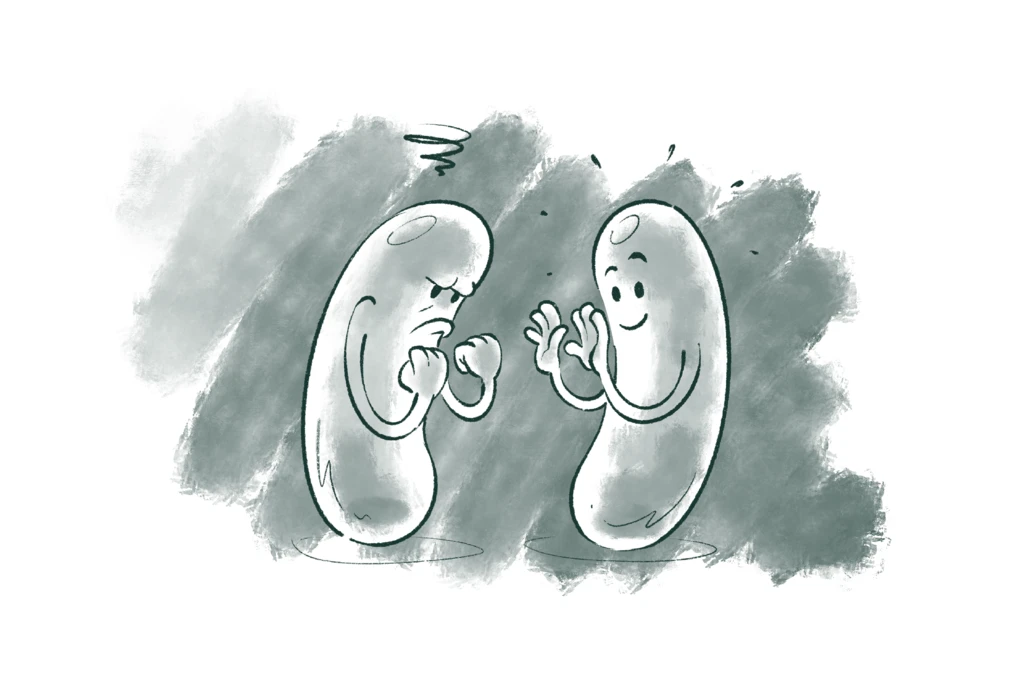Did you know that more than 800 million people suffer from hunger worldwide? And that one third of all food is wasted. It's not just the food that's wasted; it's also the water, animal feed, fertilizer, and electricity used to produce it.
The battle on food waste: Good vs bad microbes

We often find ourselves tossing out food that's stale or expired – whether it's yogurt past its expiry date, moldy cheese, stinky meat, or parched bread. It's a common reflex, isn't it?
After all, none of us want to compromise the health of our loved ones by risking food contaminated by pesky microbes – like bacteria or fungus.
But what many of us don't consider when tossing out food is the staggering scale of the problem.

Food waste is an enormous problem.
How big a problem is food waste?
Did you know that more than 800 million people suffer from hunger worldwide? And that one third of all food is wasted. It's not just the food that's wasted; it's also the water, animal feed, fertilizer, and electricity used to produce it.
Just how big is the food waste problem? According to FAO, the UN Food and Agriculture Organization, over a billion tons of food are wasted every year.
That's more than a quarter of the world's farmed area and 8-10 percent of global greenhouse gas emissions.
That's why we need to take action against food waste. And guess who we can turn to for help? Our tiny pals – microbes. Specifically, bacteria. Yep, those same little critters responsible for making your food go bad and forcing you to throw it away.
Pretty ironic, right? But the results have been downright amazing. By harnessing the power of bacteria and utilizing the effects from fermentation we can preserve food products for longer durations. This can help extend the shelf life of food products throughout the distribution chain, leading to both optimization of productivity and lower food waste.
These fermentation-enabled bacteria solutions, known as food cultures, are changing the game. But how exactly does fermentation with microbes help preserve food longer, when they're usually the reason for food spoilage and wastage? Let’s have a look in the microscope.

By harnessing the power of bacteria and utilizing the effects from fermentation we can preserve food products for longer durations.
Not all bacteria are created equal
Fortunately, not all bacteria are created equal. Our world hosts many beneficial microbes that serve as adversaries to the harmful ones. When it comes to bioprotection, scientists team up with these good microbes to combat the bad ones.
It’s a bit like the ancient proverb – “The enemy of my enemy is my friend”. In fact, that’s the very principle at play in bioprotection.
Our planet is teeming with approximately a trillion species of microbes, encompassing various bacteria, fungi, viruses, algae, and other single-celled or multicellular organisms, typically measuring less than 0.2 micrometres. To put it into perspective, a micrometre – denoted by the symbol μm – is one-thousandth of a millimeter.
However, the vast majority of the trillion species of these microbes do not pose a threat. In reality, only about 1,500 species have been identified as pathogenic or harmful microbes.
Among the trillion microbes, there exists a substantial number that prove beneficial to humans, found everywhere around us and even within our bodies. Human bodies are known to harbor more than 10,000 varieties of beneficial microbes, including bacteria.
Fermentation in action
Bacteria play an important role in maintaining good health and contributing to creating the taste and appearance that we like in our food.
Building on ancient traditions, and relying on the newest scientific insights, it is possible to ferment with good bacteria to prevent and slow down the growth of bad bacteria, yeast and molds in our food. A wise move since bad (or even dangerous) microorganisms will spoil our food or make us sick.
So, it is quite valuable to make the microflora of our food more robust against these bad microorganisms.
This article is part of The biosolutions bulletin. Want it in your inbox every month?
Naturally occurring good bacteria and fermentation can be our friends and fight our enemies in a number of ways:
- They can “eat their food” - good and bad bacteria compete for the same nutrients naturally present in our food on which they feed;
- They can “outnumber” the bad bacteria in the keen competition for space;
- They can produce natural organic compounds, known as metabolites - that attack the bad microorganisms;
- They can “send signals” in cell-to-cell communication affecting or preventing other species from spreading
But to truly comprehend the diverse ways in which friendly bacteria aid in protecting food against spoilage bacteria, we must first grasp the ancient practice of fermentation.

Thousands of years ago, our ancestors could not store food.
Fermentation: The secret behind food preservation in ancient pantries
Picture this: thousands of years ago, our ancestors could not store food – no supermarkets, no mom-and-pop stores, no refrigerators, nothing. When they hunted a nice big wild boar or harvested grain, there were no guarantees it would last through the next moon. Food was not easily available year-round. Enter fermentation, the ancient superhero of food preservation!
The ancient humans discovered that a small amount of fermented starter could kickstart the process in a large batch of unfermented food – like Egyptians used a fermented mash of ground grains and water to brew beer. This practice wasn't exclusive to Egypt. Civilizations worldwide used fermentation to preserve food, make wines and brew beers, leaving a lasting mark on culinary history.
Later revelations showed that good bacteria are the masterminds behind biological compounds called enzymes, which are a vital part of the transformation process in food. These enzymes break down carbohydrates in the food, creating acidity in food, which in turn makes the food less susceptible to attacks by bad microbes. It also adds that distinctive tangy and sharp flavor found in all fermented goodies.
Today, when food is easily available around the clock on a global scale, we are facing another problem. Once a food product rolls off the production line, the clock starts ticking towards its inevitable demise. The longer it sits on the shelf, the greater the risk of spoilage from pesky intruders like spoilage bacteria or fungi.
Think about it – tons of goodies end up in the bin mere days or months after being made, all because of their short shelf life.
Enter the brilliant minds of scientists, pondering ways to extend this shelf life without resorting to chemical wizardry. Their solution? Finding the best good bacteria to take on the bad guys!
Thus, the fermentation-enabled bioprotection revolution was born.
But identifying the right bacteria for the job isn't a walk in the park. It takes years of research, testing, and a hefty dose of patience to pinpoint the perfect candidate – good bacteria that play nice with others, are safe for human consumption and don’t mess with the food's taste or texture.
These bacterial warriors are the unsung heroes with an ability to improve shelf life and safety of dairy, meat and several other products.
Good microbes ensure that tons of food across various categories stay fresh and delicious, instead of meeting an untimely end in the trash. Let’s get a bit more technical now and dive into how these microbial superheroes are rescuing one of the most wasted food products worldwide – Yogurt. Just within the EU, around 1.5 million tons of yogurt are wasted every year.

Finding the right solution for a challenge.
Case study: Fermentation-enabled bioprotection for yogurt and its impact
In 2012, Novonesis launched its first food culture specifically developed to help enhance the bioprotective properties from the fermentation of dairy products such as yogurt, sour cream, and several fresh white cheese varieties.
This culture solution contains good bacteria that have the ability to drastically help extend the shelf-life of fermented dairy products by slowing down the growth of bad microbes – yeast and molds – known for causing spoilage. Over the past years, several new and improved generations of these food culture solutions have been launched.
Cecilie Lykke Marvig Nielsen is the Department Manager, Dairy Bioprotection Technical Support in Novonesis. She explains:
Finding the right solution for a challenge like this is a multifaceted selection process that can span between 2-5 years. During this process, we relied on our huge culture collection of more than 40,000 strains at the time, where we meticulously sifted through it to pinpoint the optimal candidate for this solution.
Cecilie points out that the team of scientists was particularly eager to find a strain that would be good at fighting the bad microbes in the fermentation process, while also prioritizing traits such as ensuring optimal product taste, texture and other important characteristics in the final dairy product. Efficacy in preserving flavor and freshness was equally high on the list.
What’s the trick exactly?
Lactic acid bacteria have been instrumental in fermentation/preservation of milk in the form of yogurt for thousands of years. During the fermentation process, the lactic acid bacteria convert the sugar of the milk into lactic acid. This lowers the pH level and renders the food product slightly acidic, which slows down the growth of unwanted bacteria. It's also the acidity that lends fermented foods their characteristic tanginess and sharp flavor profiles.
The task for the scientists was to find the lactic acid bacteria that were better than the rest at competing with the unwanted microbes for nutrient or creating an unfavorable, more acidic environment for the bad guys.
Mode of action and new research avenues
Novonesis scientists were the first to scientifically explain how the microbes fight the yeast and mold spoilage. The findings on the mode of action are documented in a scientific article featured in the prestigious Applied and Environmental Microbiology Journal. https://journals.asm.org/doi/10.1128/aem.02312-19
What the scientists discovered and proved is the ability of the good bacteria to absorb a specific nutrient in fermented milk that yeast and mold need to grow. This nutrient is called manganese. By reducing the levels of manganese in the food product, the good bacteria effectively delay spoilage and thereby help improve quality and shelf life.
Obviously, this deeper understanding of how it actually works paves the way for new research avenues. Or as Cecilie puts it:
Armed with this knowledge, we can much more targeted screen for and develop the best food cultures. Moreover, we can use this knowledge to understand how to apply the cultures in the best possible way and achieve the desired results.
From an original focus on bioprotective effects from fermentation in yogurt and cheese, researchers are now exploring how these minuscule champions can be used to protect even more food products from spoilage and food waste. It’s already possible to use food cultures to delay spoilage in e.g. fermented plant-based products, a category steeply on the rise.
Building on the inherent, transformational power of microbes, researchers are exploring to broaden the scope, which could also pave the way for healthier food with less unwanted artificial ingredients. All based on effective biological, sustainable, and less resource-intensive solutions, in short: Biosolutions.

Microbes: Invisible life forces that hold the key to our future
In this article we uncover their impact on sustainability and innovation for a more resilient future for us all.
What is a biosolution?
Microbes and enzymes are tiny but mighty agents of change. For billions of years, they’ve enabled transformation in all living things through microbiology.

What are biosolutions? Where do they come from?
How do they work? What would the world look like without them?
Get the answers to these questions and more from the monthly biosolutions bulletin. Whether you’re an expert who wants to keep on top of the latest innovations or just starting to learn about biosolutions, we’ve got you covered.
With stories ranging from the role of biosolutions in food security to how they enable NOMA-style dining experiences, there’s something for everyone.
Don’t miss out on the latest news about how biosolutions better our world. Sign up to get the biosolutions bulletin delivered directly to your inbox.
One more step…
To complete the get in touch form or sign up, please click on the button below to enable cookies.